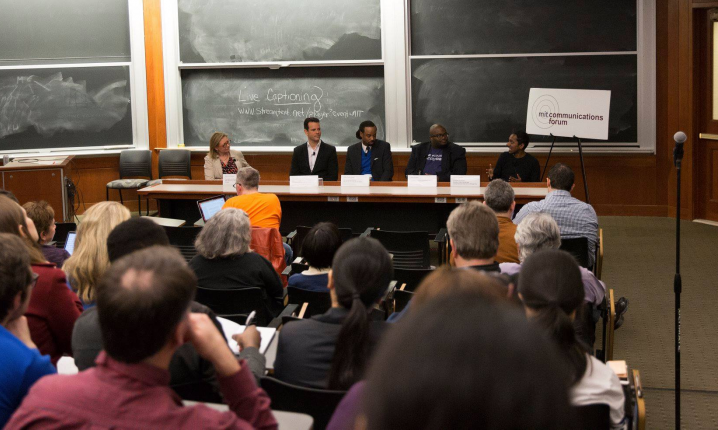By: Kollin Wasserlein
“When I think about design, I think about experience,” remarked Rafiq Abdus-Sabur, president and CEO of the Empowered Brain Institute, “If you’re designing a doorway… you want to think about all the ways people will access that doorway.”
Last March, the MIT Communications Forum held a panel entitled “Designing for a Neurodiverse World,” sponsored by Radius at MIT and the MindHandHeart Innovation Fund, a fund supporting innovative projects related to mental health and wellness at MIT. The speakers have dedicated their lives to opening doors for those who think differently.
Abdus-Sabur was joined by neuroscientist and CEO of Brain Power LLC Dr. Ned Sahin; Founder and Director of MIT’s Affective Computing Research Group and MIT Media Lab Professor Rosalind Picard; Disability Advocate and Policy Analyst Finn Gardiner; and Computer Scientist and Founder of the Cambridge Computational Clinical Psychology Org (C3PO) Karthik Dinakar, to discuss designing with and for “neurodiversity”—the broad range of neurological differences like autism, dyslexia, ADHD, or epilepsy, that may be present among users.
There are many different ways to be neuroatypical. As Gardiner explained, “A person with an intellectual disability is neurodivergent, but if you are so intellectually advanced that the school curriculum doesn’t fit you, then you are neurodivergent.” With so many different types of minds, it can seem impossible to design systems and products for everyone. However, designing for those on both ends of a spectrum can result in a product that is useful to most people, including those who are usually left out.
Discussion centered on the question of “universal design”— design that is inclusive of all members of society, including those in the middle and on the ends of a neurodiverse spectrum. Sahin, who works alongside Abdus-Sabur at the Empowered Brain Institute, discussed their jobs training program for individuals with autism and traumatic brain injury. After graduating from college, he noted, people diagnosed with autism have an 80% unemployment rate.
“What’s important for helping someone with autism get a job?” asked Sahin. “Making eye contact with the interviewer… trying to determine if you are talking too much, or not talking enough; the appropriate language and level of language; whether to use a swear word in certain contexts; how to operate around that proverbial water cooler. Which of these things is [only applicable to those with] autism, and is not applicable to anyone else? Nothing.”
“We ended up generating essentially an interview training program, useful for all… If you take seriously that we’re all on the spectrum, the flip side of that is that tools well-tuned for people that have the tougher version of the regular human challenge of interacting with others… may be broadly applicable to all.”
Discussion concluded on MIT’s role in the future of universal design. For many students and faculty at the Institute, there is no better place to find an accepting community for neurodivergence. “It was kind of liberating for me to get the eventual diagnosis,” said Dinakar, who was diagnosed with autism while a student at MIT. “I didn’t see it as a label. I think a large part of why that was so empowering for me is I was in a community of people where neurodiversity is celebrated.”
Audio and a summary of the panel is available on the MIT Communications Forum’s website.



